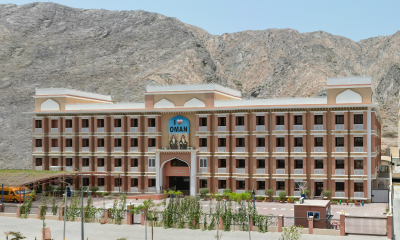Health Care
Development of healthcare sector takes center stage in GCC countries
According to the recent Alpen Capital report, development of the healthcare sector has taken a center stage in the GCC countries, as they witness an era of demographic transition accompanied by rising prevalence of lifestyle-related diseases.

According to the recent Alpen Capital report, development of the healthcare sector has taken a center stage in the GCC countries, as they witness an era of demographic transition accompanied by rising prevalence of lifestyle-related diseases. High spending power as well as changes in dietary habits and lifestyle has led to high incidence of diabetes, obesity, and cardiovascular diseases among the region‟s residents. Such factors along with a high population growth are exerting pressure on the existing healthcare system.
Consequently, the GCC governments are injecting huge funds as well as encouraging private sector participation to build hospitals and clinics, upgrade the existing infrastructure, and match the quality of services offered in the developed countries. The member nations are also investing heavily in technologies such as the digitization of patient records and e-visits.
The rollout of mandatory health insurance schemes in all the countries is further accelerating the growth of the sector. Over a period of five years up to 2013, healthcare expenditure in the GCC grew at a CAGR of 10.3% to US$ 49.5 billion. Saudi Arabia and the UAE are the largest markets, collectively accounting for nearly three-fourth of the region‟s spending on healthcare.
However, at 3.1% in 2013, total healthcare expenditure as a percentage of the aggregate GDP of the GCC nations was considerably below the world average of about 10%. High oil prices for most part of the period enabled the GCC governments to shoulder a large portion of the overall healthcare expenses. In 2013, the government funded 70.3% of the total spending, considerably higher than that of 49% in North America and 60% average of the world. Private expenditure in the sector grew at an 8.8% CAGR between 2008 and 2013, slower than that of 11.0% growth in government spending.
Within the GCC, Bahrain had the highest healthcare spending as a percent of GDP at 4.9% in 2013, while Qatar had the lowest at 2.2%. The spending ratio across the member nations was very low compared to that in the developed countries such as the US, the UK, and Germany.
Healthcare spending in Qatar, Kuwait, and Bahrain grew at the fastest pace within the GCC between 2008 and 2013. The growth is primarily due to a lower base of healthcare expenditure. Spending growth in the UAE was the lowest in the region. Nevertheless, the country‟s per capita healthcare spending was the second highest, after Qatar, owing to rising affluence levels and prevalence of chronic diseases. Driven by the governments‟ huge investments to develop the healthcare sector, the total expenditure per capita in the GCC is getting closer to the global average, but substantially lower than that in North America.
Rising population amid improving life span as well as mortality rates and high occurrence of lifestyle-related diseases are fostering the need for healthcare services. The GCC population is more than 50 million, which has grown at a 4.4% CAGR over the last decade to 20145 aided by inflow of expatriates. The region‟s population is concentrated in the young and the working-age categories, with 24.3% below 15 years of age and two-third of the population aged 15-49 years in 2014. The dietary habits such as intake of fast foods among the young and working, who have less physical activity has resulted in a growing incidence of diseases such as cardiovascular ailments, diabetes, depression, anxiety, and nutritional disorders.
Sustained focus on healthcare has improved key health indicators such as life expectancy at birth, infant mortality rate, and crude death rate. The average life expectancy at birth in the GCC is about 77 years, which is close to that in North America and above the global average. Oman, in particular, has seen an impressive improvement in life expectancy, which increased to 77 years in 2013 compared to 69 in 1993. A rise in the life expectancy has increased the time span over which an average person requires healthcare services. Another health indicator that has improved remarkably is the infant mortality rate.
The GCC region, on an average, registered over eight infant deaths per 1,000 live births in 20136 (see Exhibit 8). Within the region, the mortality rate was the highest in Saudi Arabia and Oman, which is substantially higher than that in the North America. Although higher than that in the developed countries, the GCC average infant mortality rate has dropped drastically, having more than halved in 2013 from over 18 in 1993. Some nations in the GCC have achieved the infant mortality rate targets listed under Millennium Development Goals set by the WHO. In 2013, the median crude death rate of three per 1,000 people in the GCC was much below the North American and EU rates of 8 and 10, respectively .
Such robust improvement in key health indicators denotes that the nations have increased the access to, as well as enhanced the quality of healthcare delivery. Increased longevity, a decline in the infant mortality rate, and low crude death rate build the case for a rise in demand for primary healthcare facilities.
-

 Banking & Finance2 weeks ago
Banking & Finance2 weeks agoOman Oil Marketing Company Concludes Its Annual Health, Safety, Environment, and Quality Week, Reaffirming People and Safety as a Top Priority
-

 Economy2 months ago
Economy2 months agoMaal Card: What Oman’s New National Payment Card Means for Everyday Users
-

 Events2 months ago
Events2 months agoOER Corporate Excellence Awards 2025 Honours Entities and Innovations in Oman
-

 News2 months ago
News2 months agoSheikh Suhail Bahwan, Chairman of Suhail Bahwan Group, Passes Away
-

 News1 month ago
News1 month agoOIG Appoints New CEO to Lead Its Next Chapter of Excellence
-

 Economy2 months ago
Economy2 months agoOman Unveils Official Omani Rial Symbol in Landmark Move to Boost Global Currency Presence
-

 News1 month ago
News1 month agoReport: How India & The Middle East Are Exploiting Immense Economic Synergies
-

 Uncategorized1 month ago
Uncategorized1 month agoOman’s ISWK Cambridge Learners Achieve ‘Top in the World’ and National Honours in June 2025 Cambridge Series



























You must be logged in to post a comment Login